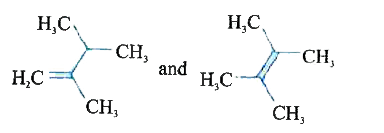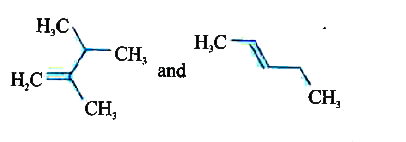An alkane with formula C6H14 can be prepared by reduction (with Zn and H+) of only two alkyl chorides (C6H13Cl) and by the hydrogenation of only two alkenes (C6H12) write structure of this alkane.
Topper's Solved these Questions
- HYDROCARBONSBOOK - FIITJEECHAPTER - HYDROCARBONSEXERCISE - EXAMPLE
4 Videos
- HYDROCARBONSBOOK - FIITJEECHAPTER - HYDROCARBONSEXERCISE - SOLVED PROBLEMS (SUBJECTIVE)
21 Videos
- GENERAL ORGANIC CHEMISTRYBOOK - FIITJEECHAPTER - GENERAL ORGANIC CHEMISTRYEXERCISE - SINGLE INTEGER ANSWER TYPE QUESTIONS
14 Videos
- IONIC EQUILIBRIUM BOOK - FIITJEECHAPTER - IONIC EQUILIBRIUM EXERCISE - SINGLE INTEGER ANSWER QUESTIONS
4 Videos
Similar Questions
An alkane C6H14 gives onlt two monochloroalkanes on chlorination. What is the structure of the original alkane ?
View SolutionAn alkene (A) with molecular formula C_(7)H_(12) adds HBr to give a single alkyl halide (B) (C_(7)H_(13)Br) .(A) on catalytic hydrogenation gives 1 1 -dimethyl cyclopentane.The alkene (A) is
View Solution
Knowledge Check
An alkane with the formula C6H14 can be prepared by the hydrohengation of only two alkanes (C6H12) IUPAC name of the alkane is :
A2,2-dimehtylbutaneB2,3 - dimethylbutaneC2- methylpentaneDn- hexaneOptically active 'P' has the molecular formula C6H12 and catalytic hydrogenation converts into achiral C6H14 . The structure of 'P' is -
A B
B C
C D
D
An alkyl halide of formula C6H13CI on treatment with potassium t-butoxide given two isomeric alkanes (C6H12) . Both alkenes on hydrogenation give 2,3 dimethyl butane. Isomeric alkanes are
A B
B C
C D
D
An alkane with the formula C5H12 undergoes chlorination to give only one product with the formula C5H11Cl. What is the structure of this alkane?
View SolutionAn alkane with the formula C5H12 undergoes chlorination to give only one product with the formula C5H11Cl. What is the structure of this alkane?
View SolutionAn alkene (A) with molecular formula C7H12 adds HBr to give a single alkyl halide (B) (C7H13Br). (A) on catalytic hydrogenation gives 1 ,1 -dimethyl cyclopentane.The alkene (A) is
View SolutionAn alkyl halide (X)of the folmula C6H13Cl on treatment with potassium tertiary butoxide gives two isomeric alkenes (Y) and (Z)(C6H12). Both the alkenes on hydrogenation give 2,3−dimethyl butane. Perdict the structures of (X),(Y) , and (Z)
View SolutionAn alkane with a molcular formula , C6H14 reacts with clorine in the presence of light and head and heat to give two constitionally C6H13Cl . What is the most resonbale starting alkane ?
View Solution

